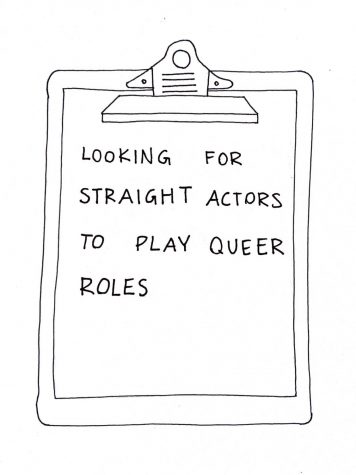
Elio in “Call Me By Your Name.” Queen Anne of England in “The Favourite.” Rayon in “Dallas Buyers Club.” In addition to being award-winning roles, these characters were all part of the LGBTQ+ community. However, none of the actors identified as LGBTQ+. These actors, and many of the other straight actors that have portrayed queer characters in the past, have received major backlash for taking away roles from LGBTQ+ actors. Although many believe that these roles should be reserved for queer actors, increasing selectivity within roles would perpetuate the isolation of the LGBTQ+ community within the entertainment industry and lessen queer representation. Instead, actors should be cast based on talent rather than sexual orientation.
Hollywood’s LGBTQ+ discrimination goes deeper than casting straight actors in gay roles. Unfortunately, a lot of times, if a straight actor is not selected to play an LGBTQ+ character, the character will not be represented at all. Typically, the front runners for Academy Awards are heterosexual. During the 2020 Academy Awards, both the categories for Best Actor and Best Actress had all presumed heterosexual nominees. Because directors want their movies to generate Oscar buzz, they are more likely to put straight actors in their roles because they are more well-known.
According to Insider, openly gay actor Michael James Scott believes that it is worth casting a straight actor in a queer role to increase popularity in the film while promoting LGBTQ+ characters.
“A bigger star or bigger name helps the film to get made, and also helps it to get shown out there more,” Scott said.
The Gay & Lesbian Alliance Against Defamation (GLAAD) Media Institute tracks the portrayal of queer characters on primetime television and on streaming services. According to their data, there was an eight character increase of recurring LGBTQ+ characters on cable from 2016-2017. In the same year, there was an increase of six LGBTQ+ characters on streaming services like Amazon, Hulu and Netflix, up from 59 to 65. If queer roles had been limited to LGBTQ+ actors, these numbers would have likely been much lower.
While there has been an increase in representation, that doesn’t mean that LGBTQ+ actors should be confined to queer roles. In the same way that straight actors should not be denied a queer role, queer actors should not be denied a straight role. For example, Neil Patrick Harris, an openly gay actor, has played multiple straight characters, including nine years as Barney Stinson, a total ladies’ man, on sitcom “How I Met Your Mother.”
Reserving queer characters for LGBTQ+ actors puts closeted actors in an uncomfortable position and does not allow actors to express themselves through different characters. They must conform to one classification of themselves, which defeats the purpose of acting and deliberately typecasts actors.
Although typecasting can be a way to make an actor known for a certain kind of role, it often appoints actors based on what viewers are comfortable seeing rather than on talent. However, if a casting director feels that an actor is right for a role, they should cast them regardless of their sexuality.
In other professions, sexual orientation is not discussed in the hiring process. Laws enforced by the US Equal Employment Opportunity Commission (EEOC) make it illegal for an employer to make any employment decision because of a person’s sex (including gender identity, sexual orientation and pregnancy).
Because people have been historically discriminated against on the basis of their sexual orientation, many opt to not discuss personal details in the workplace. Unfortunately, the strong media presence on those in the entertainment industry does not allow this kind of privacy. Actors are constantly scrutinized for each outing they take with speculations about who they are dating. If this atmosphere consistently questions personal details about these individuals, they should not be able to use this information against them when casting.
Although LGBTQ+ representation has increased, the entertainment industry still produces content geared towards a heterosexual audience. A lot of straight actors are praised for their portrayal of a queer character, but, often, queer actors will not even be considered for straight roles. This dynamic in Hollywood cannot continue, but this means that casting directors must become more open-minded, not that queer roles should be limited to queer actors.








